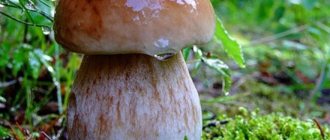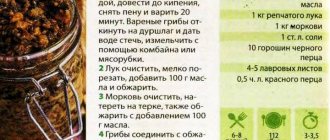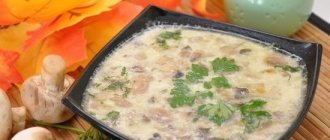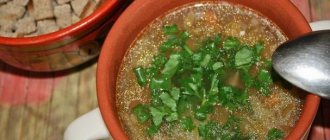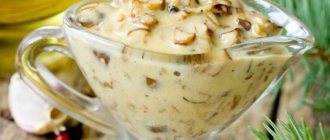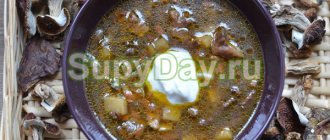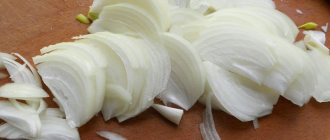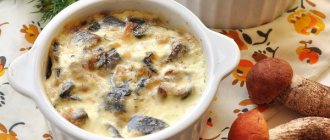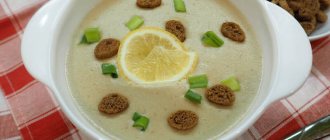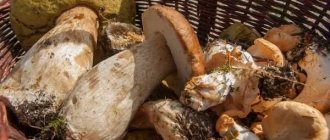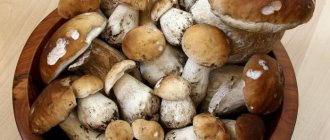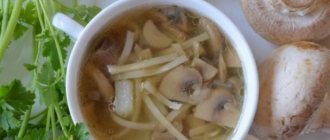The easiest option is to place a photo in your passport, and when you write a message, at the bottom of the message text there will be the phrase “Add a picture to the message”, select the appropriate photo and that’s it.
Here is a photo of cooked mushrooms. the hats were all green. the onion did not change color (I cooked the onion with mushrooms)
That’s why I only eat what I’ve collected myself and only what grows in Karelia, where toadstools cannot be confused with a mushroom.
Celebrities trending
Our website uses cookies to improve your experience and make the site more efficient. Disabling cookies may cause problems with the site. By continuing to use the site, you agree to our use of cookies. It's clear
The easiest option is to place a photo in your passport, and when you write a message, at the bottom of the message text there will be the phrase “Add a picture to the message”, select the appropriate photo and that’s it.
Types of treatments, percentage loss of weight and nutrients of the product “Fresh Champignon Mushrooms”
| Treatment* | Cold working losses: | Heat treatment losses: | Losses after heat treatment: | Protein loss | Fat loss | Loss of carbohydrates |
| Frying in slices (Supervisor) | 0,00 | 39,30 | 0,00 | 5,00 | 10,00 | 0,00 |
| Frying from raw materials (control according to specifications) | 23,70 | 51,06 | 0,00 | 5,00 | 10,00 | 0,00 |
| Raw for salad | 5,00 | 0,00 | 0,00 | 0,00 | 0,00 | 0,00 |
| Frying slices from raw | 0,00 | 60,00 | 0,00 | 5,00 | 10,00 | 0,00 |
| Whole cooking | 0,00 | 30,00 | 0,00 | 5,00 | 5,00 | 0,00 |
Champignon mushrooms are fresh, and 1100+ other products are available at Chef Expert! Read more…
Cleaning
Each mushroom must be inspected and processed with an “individual approach”: for some, remove the skin from the cap, for others, cut off the stem, for others, cut into pieces. Some mushroom pickers dip the boletus into boiling water for a minute - this makes it easier to peel the skin; some are categorically against water when cleaning and clean everything “dry”. After cleaning, some housewives dip the mushrooms in salted and/or acidified water (1 teaspoon of salt and 2 g of citric acid per 1 liter of water) so that they do not darken.
How to distinguish doubles?
Edible mushrooms, which are hunted by mushroom pickers, have counterparts - inedible, conditionally edible or poisonous. Here are the most famous pretenders:
- Gall and satanic mushroom. These are twins of boletus - the most valuable representative of the mushroom kingdom. But distinguishing doubles is easy. The first one has a dark network of veins on the leg, the second one has a reddish one. You can also cut off a piece of the leg to see if its color changes. If after a minute the color of the cut does not change, the boletus can be placed in the basket. In twins, the color will change from white to pink - for the gall mushroom, and purple - for the satanic mushroom.
- False boletus. His hat is darker than the real one. The color of the cut leg does not change, but in a real redhead, on the contrary, it darkens.
- False boletus. It can be distinguished from an edible mushroom by its darker cap and bluish cut. Another sure sign is the place of growth. False boletus does not grow under birch trees.
- False chanterelles. To distinguish them from edible ones, you need to be careful. Look at the color of the hats. In real chanterelles they are light orange, almost yellow. False specimens have a bright orange color, and when broken, drops of white juice appear.
- False honey mushrooms. There are many poisonous and inedible mushrooms that look similar to honey mushrooms. Real mushrooms can be distinguished from false ones by their brownish or brownish-yellow scaly cap. Moreover, the caps are pale, while the false caps are bright, for example, red-brown or rusty-red. Edible honey fungus can also be identified by its smell - it has a pleasant and rich mushroom spirit. False mushrooms emit the smell of mold and damp earth.
When cooking the mushroom, a green coating formed
Grows in spruce and mixed forests. You can see it from mid-July to the end of August. It differs from other varieties of porcini mushroom in the color of its cap (reddish-brown or chestnut-brown). The spongy layer is white or light yellow, less often greenish, in old mushrooms it is granular or dark green. The leg is long, there is a white mesh pattern under the cap. Mushroom of the highest category. Edible! It has a strong pleasant mushroom smell and taste. It is eaten fried, boiled, salted, pickled, and dried. Soups, salads and various flour products with this mushroom are also good.
WHITE MUSHROOM (Pine or Borovoy).
One of the forms of the common porcini mushroom, it forms mycorrhiza more often with coniferous trees (pine). Grows in pine forests and old pine trees. You can visit from mid-June to the end of October, sometimes until mid-November. It differs from other forms of porcini mushroom by its dark, hard and brittle cap, often wrinkled and moist. The spongy layer is white or light green; in older mushrooms it is darker and greener. The leg is thick, strong, white with yellowish tint, and has a mesh pattern. Doesn't change color when broken. Mushroom of the highest category. Edible! The taste is not inferior and even superior to other forms of porcini mushroom.
One of the forms of porcini mushroom. Found in deciduous and mixed forests, birch groves, and less commonly in aspen and poplar groves. It can often be found along forest edges, clearings, forest edges and even in fields. Loves well-lit places. Grows from mid-June to mid-October. The hat is lighter than other forms. Color ranges from almost white to light brown or yellow. The leg is long, softer than other forms, the sponge is light green or lemon, in old mushrooms it is dark green. There is a mesh pattern on the leg. Mushroom of the highest category. Edible! It is not inferior in taste to other forms of porcini mushroom. Dried and fried horsh.
One of the forms of boletus. It is found in almost any type of forest, most often in mixed ones. Grows from early June until frost. The cap is convex, in young mushrooms it is curled. The color is from yellow to orange or yellow-brown. The tubular layer is from white to off-white or grayish. The leg is thick, strong with a “birch” pattern of black, sulfur or red-brown color. Mushroom of the highest category. Edible! It has a strong pleasant mushroom smell. The leg darkens at the break. When cooked, the mushroom produces a very rich black broth, which must be drained several times. Horsch mushroom in fried, boiled, pickled, salted form, as well as in the form of mushroom powder or paste. It is dried less often due to the excessive blackness of the dried mushroom.
In addition, few people know that they cannot be 100% classified as plants, since they contain signs of the animal world too. There are about 1.5 million species, subspecies and varieties of mushrooms in nature. This figure is a bit approximate, since scientists and avid mushroom pickers are discovering more and more new specimens. Science does not have an exact number of edible and poisonous mushrooms. It is believed that their percentage is 50/50, that is, they are equally divided.
Do saffron milk caps turn green?
Saffron milk caps are the name given to a large group of mushrooms of the genus Milky. They are valued for their good taste and are considered a delicacy in many countries. The fruiting body consists of a cap measuring from 4 to 18 cm. It has a convex shape, over time it becomes straight or funnel-shaped. The surface of the mushroom is smooth, glossy, and after rains an adhesive layer appears on it.
The height of the leg is from 3 to 7 cm, its girth reaches 2 cm. It is smooth, cylindrical in shape, tapering towards the ground. The color of the cap varies: from yellowish to dark orange. The flesh is also orange in color. A green coating often appears on the cap, which is characteristic of adult mushrooms.
Often saffron milk mushrooms turn green after processing. This is a natural process that does not affect the quality and taste of the product. Therefore, you should not be afraid of specimens that have changed color. If the fruiting bodies are of good quality and without damage, then they are taken for collection and processing.
Growing
Porcini mushroom, despite its unsurpassed taste, is not grown on an industrial scale - it is unprofitable. Usually, amateur gardeners are engaged in cultivation. There must be coniferous or deciduous trees on the personal plot. There should be no fruit trees, cultivated shrubs or vegetables nearby. The most difficult thing in growing boletus is creating conditions for the successful creation of connections between tree roots and mycelium.
It is desirable that the site is adjacent to the forest. If this is not possible, you need to have at least a few pine, aspen, birch, oak or spruce trees on your future “plantation.” Trees on the site must be at least 8 years old. There are two ways to grow porcini mushrooms – from mycelium and from caps.
Growing from mycelium
Cultivation begins with the purchase of planting material. You need to buy mycelium in specialized stores. Next, prepare the area and plant the mycelium:
- The soil is exposed near the trunks. The top layer is removed - approximately 20 cm. The diameter of the circle should be approximately 1-1.5 m. The removed soil is saved - it will be needed to cover the crops.
- A layer of peat is applied to the area prepared for planting. Rotted compost can be used. The fertile layer should not be thicker than 2-3 cm.
Before frost, areas with mushrooms are covered. For insulation you can use moss, spruce spruce branches, fallen leaves. With the arrival of spring, the insulation is raked using a rake.
A year will pass and the first fungi will be removed. If you properly care for the mycelium, water and feed it on time, the mushroom “plantation” will bear fruit for up to 5 years.
Growing from caps
To implement this method, you will need to get a few mushroom caps. Find mature, or better yet, overripe boletus mushrooms in the forest. The diameter of the cap should be at least 10 cm. It is best that when broken, the cap has a greenish tint - this indicates the maturity of the spores.
When collecting caps, you need to remember what trees the mushrooms grew under. It will be necessary to sow spores under the same trees. If a boletus is found under a spruce, it is unlikely that it will take root under a birch or aspen.
The procedure for preparing the site and planting seed:
- About a dozen caps are soaked in a bucket of water. It is advisable that the water be rainwater. Add one thing per 10 liters: alcohol - 3-5 tbsp. l.;
- or sugar – 15-20 g.
Mushrooms should be soaked no later than 10 hours after collection - otherwise they will spoil. After 24 hours, you should mash the boletus caps. Knead until you get a mass similar to jelly. After straining it through cheesecloth, the water is separated from the mushroom tissue with spores.
Tea is brewed in 1 liter of boiling water. The second option is to boil oak bark for 1 hour. Water the soil with the cooled solution - 3 liters for each tree.
- Next, they begin planting - water containing boletus spores is poured onto the prepared fertile layer. The solution is stirred while pouring. The crushed caps are placed on top, the planting is covered with previously removed soil, and covered with straw.
Boletus mushrooms can reach a yield of up to 250 kg per 1 hectare. Under each tree, during the season, you can collect a bucket of porcini mushrooms.
All that remains is to take care of the crops - water them regularly, sparing no water. If the soil dries out, the mycelium will die before it has time to germinate. For the winter, the area is insulated with spruce branches or leaves. In the spring - they rake. The first mushrooms will appear next summer or autumn.
How to check if mushrooms are poisonous when cooked?
You can use the following popular method. All you need is an onion. So how to check for poisonous mushrooms? When cooking these products, throw an onion, cut in half, into the pan. If the vegetable turns blue, then the mushrooms should be thrown away, as they are poisonous. These products can cause serious poisoning.
How to check whether a mushroom is poisonous or not? As can be seen from the many verification methods, it is difficult to know for sure. Remember that using such unscientific methods can result in mortal danger!
Cooking mushrooms is considered the simplest type of processing of this forest product. How much time you need to devote to the procedure depends on the type of mushroom. They are supposed to be boiled not only to obtain a tasty dish, but also to cleanse food from substances harmful to health.
Preparing for cooking
Mushrooms often contain compounds that are hazardous to health, because... capable of absorbing them from the external environment.
That is why the first mushroom broth needs to be drained and then boiled in new water. Thanks to this procedure, forest gifts can be cleaned of insects, bacteria and other things. Sometimes parts of the fruit bodies that have not been cooked become bitter. That is why heat treatment is required even for ordinary rows, chanterelles, and champignons, especially if they are bitter.
How long should you cook mushrooms before frying and why should you do this?
Preparing for cooking
Boil porcini mushrooms for 30-50 minutes
Boil chanterelles and boletus for 20 minutes
Boletus and russula are boiled for 30-40 minutes
Boil butter and mushrooms for 25-35 minutes
How to properly prepare wild mushrooms for cooking and how long to cook? With them everything is more complicated than with the familiar champignons and oyster mushrooms. Wild mushrooms require careful cleaning and high-quality rinsing with running water. Of course, if you have time, it is best to soak them for 10 minutes, which will greatly facilitate the process of removing dust and dirt.
Wild mushrooms have their own characteristics in preparation, which are different for each individual variety. For example, milk mushrooms, in addition to preliminary cleaning, require additional soaking in salted water for 1-2 hours. They cook in 15-20 minutes. Cooking porcini mushrooms and honey mushrooms will take a little longer.
It is necessary to first remove the skin from the caps of chanterelles and boletuses. These wild mushrooms are boiled in a large volume of salted water for 20 minutes. As for boletus and russula, they will be ready in 30-40 minutes. Butter and mushrooms must be cooked for 25-35 minutes. Morels require pre-soaking in cold water for about 1-2 hours. They cook for about 30 minutes.
When preparing duboviks, volnushki and svinushki, you need to be very careful. Such forest mushrooms should be pre-soaked in several waters; the cooking process is also carried out in stages - the water is changed several times. If you are not confident that you can properly prepare duboviki, volnushki and svinushki, it is better not to risk your health or the health of your loved ones.
Flattering mushrooms are very tasty and aromatic, but do not forget that some of their varieties are dangerous. Therefore, if you are not sure that you can cook them correctly, do not take on this task.
Mushrooms are a universal product in any cook’s arsenal. They can be used in various recipes: as a side dish, as part of first and second courses, in salads, sauces, appetizers. Mushrooms are rich in extractive substances that are responsible for their bright aroma and taste. But improper heat treatment can deprive them of these qualities. Knowing how long to cook mushrooms and how to do it correctly will allow you to create a real culinary masterpiece.
How long to cook
The cooking time for mushrooms depends on their type. To determine how long to cook, use the following guide:
- champignons, coral mushrooms: 5–10 minutes;
- milk mushrooms, oyster mushrooms, saffron milk caps, row mushrooms, kids, puffballs, eringi: 15–20 minutes;
- boletuses, chanterelles, podgruzki, cherry blossoms: 20 minutes;
- honey mushrooms, boletus, russula, fly mushrooms, boletus mushrooms, govorushki, oak mushrooms, May mushrooms, tinder fungi: 30 minutes;
- whites: 35–40 minutes;
- boletus mushrooms: 40–50 minutes;
- morels: 1 hour.
How to identify edible mushrooms (video)
Also, during the cooking process, it is supposed to remove poison from the fruiting bodies by adding a vinegar-salt solution. The method is not bad when cooking mushrooms with low-toxic pulp, such as strings, but when used to neutralize the poison of toadstool or other highly toxic mushrooms, it is absolutely useless.
Many mushroom pickers are still confident that the use of pre-boiling for a long time helps to completely remove poisonous, toxic substances from the mushroom pulp. But, unfortunately, all the most dangerous poisons are heat-resistant, and even very long boiling has no effect on them.
Beginning mushroom pickers often focus on the smell of the mushroom when picking mushrooms. It should be noted that the erroneous belief that a poisonous mushroom necessarily has an unpleasant and specific odor most often becomes the cause of serious poisoning. For example, the aroma of champignon is practically indistinguishable from the smell of the pulp of the most dangerous, deadly poisonous mushroom - toadstool. Among other things, different people perceive odors very differently and cannot serve as an assessment of the quality and edibility of a mushroom.
Mushroom pickers should definitely adhere to five basic rules of “quiet” hunting:
- all dangerous, deadly poisonous types of mushrooms must be “known by sight”;
- it is important to carefully examine the mushrooms you collect and be able to distinguish edible species from look-alike mushrooms;
- It is forbidden to collect mushrooms in industrial zones and near highways;
- It is not recommended to pick mushrooms in dry and hot weather;
- You cannot collect overgrown mushrooms, even of edible species.
You may be interested in:
Few people know how to identify poisonous mushrooms when cooking.
Preparing for freezing and drying
The general rules in the case of drying and freezing change by one point: contact with water is excluded here. That is, neither quick rinsing nor, moreover, soaking is carried out. To remove dirt efficiently, use a cloth instead of water, slightly moistening it for better adhesion of debris, or a brush from a hardware store, or even an old toothbrush.
The sequence is:
- first remove all large debris from the cap and stem, clean off the root part with a knife;
- remove all fragments that are beginning to rot or have darkened for another reason;
- update the cut, look inside the leg, usually the worminess begins there; remove the part of the fruit body eaten by worms;
- scrape the stem with a knife as a final finishing action.
At the end, you can go over the surface again with a cloth (a new one, not the one you used at the beginning of the cleaning process) and start cutting before drying or freezing.
Contraindications
Porcini mushrooms are an amazing gift of nature; many useful substances are present in concentrated form in their tissues. The ability to accumulate elements can be harmful - fruiting bodies collect and retain heavy metal salts and toxins, like a sponge. Old specimens are especially prone to this, so collecting them is undesirable.
In addition, you should refrain from quiet hunting along highways and near factories, and when leaving the city, you need to find out in advance how the wind rose is located and avoid directions where the wind carries industrial emissions.
Mushroom dishes, which are generally considered heavy food, are not recommended for children under seven years of age and pregnant women.
Reduced acidity of gastric juice, metabolic disorders and pancreatic function are also contraindications to the consumption of these saturated foods.
How not to get poisoned?
A variety of dishes with mushrooms are present in almost all cuisines of the world. However, you should not engage in independent collecting if you are not confident in the accuracy of your knowledge and ability to distinguish edible from poisonous. Observing the period (1 day) and storage conditions (in a cool place without direct sunlight). You can safely prepare a delicious product. Advice: mushrooms are not prepared or stored in aluminum, zinc, or ceramic dishes with glaze to avoid oxidation or reaction of some substances contained in them with the material of the dishes.
A careful attitude towards quiet hunting, as mushroom pickers call collecting the gifts of nature, will help to avoid poisoning. Take only those that you know well. Do not pick mushrooms near a highway, railway track or industrial enterprise.
You have come from the forest, you feel pleasantly tired, and on the table there are only collected mushrooms, alluring with their smell, waiting to be processed. And then you realize that you are not sure that you can eat them. How can you check whether a mushroom is poisonous or not at home? There are many ways to do this. But, unfortunately, it is impossible to reliably determine whether there are poisonous mushrooms among the collected mushrooms.
Here are a few options to help you check. We will also consider myths in parallel.
